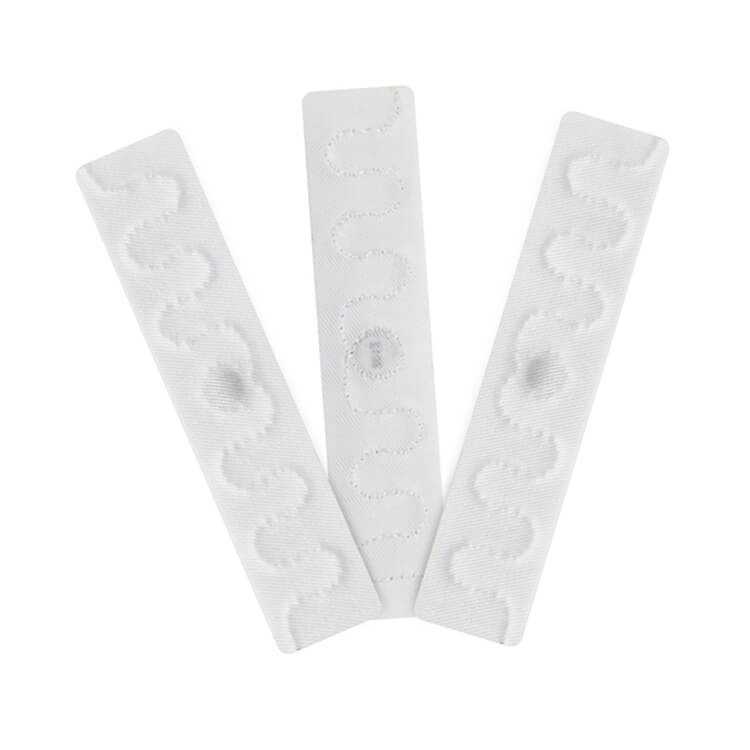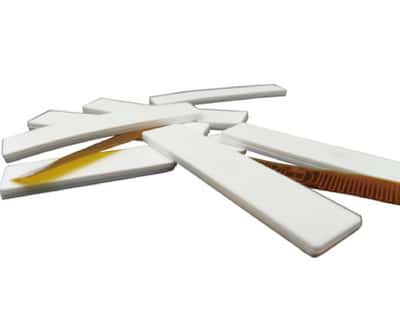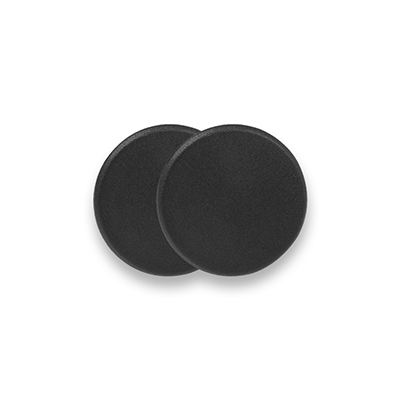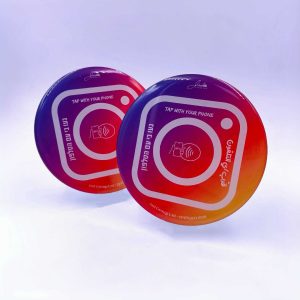RFID stands for radio frequency identification, and it is a technology that uses radio waves to transmit data from a tag to a reader. RFID tags are widely used in various applications, such as inventory management, access control, asset tracking, and more. But did you know that you can also make your own RFID tags at home? In this article, we will show you how to make an RFID tag from scratch, and answer some common questions about RFID tags.
What is an RFID Tag?
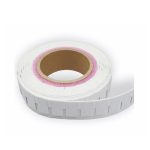
An RFID tag is a device that consists of three parts: a chip, an antenna, and a substrate. The chip stores the data that identifies the tag, such as a serial number or a product code. The antenna receives and sends radio signals to the reader. The substrate is the material that holds the chip and the antenna together, and it can be paper, plastic, metal, or other materials.
There are two main types of RFID tags: active and passive. Active RFID tags have a battery that powers the chip and the antenna, and they can transmit data over long distances. Passive RFID tags do not have a battery, and they rely on the reader’s radio waves to power the chip and the antenna. Passive RFID tags are cheaper and smaller than active RFID tags, but they have a shorter read range.
How to Make an RFID Tag at Home?
If you want to make your own RFID tags at home, you will need some basic tools and materials, such as:
An RFID reader and a software that can encode data to the tag
An RFID chip or an integrated circuit (IC) that can store data
An RFID antenna or a coil of wire that can receive and send radio signals
A substrate or a material that can hold the chip and the antenna together
A soldering iron and some solder
A glue gun or some adhesive tape
Here are the steps to make an RFID tag at home:
Choose which memory bank you want to store your data on. An RFID tag has four memory banks: Reserved, EPC, TID, and User. Only the EPC and User memory banks are re-programmable. The EPC memory bank is the most commonly used one.
Choose which numbering system you want to use to represent your data. You can use hexadecimal (Hex) or ASCII. Hex uses numbers 0-9 and letters A-F, while ASCII uses the entire English alphabet and some symbols.
Connect your RFID reader to your computer and launch the software that can encode data to the tag. You can use different software depending on your reader model and preference. For example, you can use ThingMagic’s Universal Reader Assistant (URA) or PEERNET Reports.
Place your RFID chip near the reader antenna and enter the data you want to encode in the software. You can also upload an Excel file with multiple data records if you want to program multiple chips at once.
Click on the encode or print button in the software. Your RFID chip will be programmed with the data you entered.
Solder your RFID antenna to your RFID chip. Make sure that the antenna is connected to the right pins on the chip, and that there is no short circuit between them.
Glue or tape your RFID chip and antenna to your substrate. You can use any material that is thin and flexible, such as paper, plastic, or fabric.
Test your RFID tag by placing it near the reader antenna and reading the data from the software.
Congratulations! You have just made your own RFID tag at home!.
How to Make Passive RFID Tags?
Passive RFID tags are easier to make than active RFID tags because they do not require a battery or a power source. You can follow the same steps as above to make passive RFID tags, but you will need to use passive RFID chips and antennas that are compatible with your reader’s frequency.
There are three main frequency bands for passive RFID tags: low frequency (LF), high frequency (HF), and ultra-high frequency (UHF). LF tags operate at 125 kHz or 134 kHz, HF tags operate at 13.56 MHz, and UHF tags operate at 860 MHz to 960 MHz.
You can buy passive RFID chips and antennas online or from electronic stores. You can also make your own passive RFID antennas by winding a coil of wire around a cylindrical object, such as a pen or a straw.
How to Make Your Own RFID Tag?
f you want to customize your own RFID tag with your own design or logo, you can use printable substrates or labels that have an embedded RFID chip and antenna. You can print your own design or logo on the substrate or label using an inkjet or laser printer, and then encode the RFID chip using the same steps as above.
You can also use RFID stickers or inlays that have an adhesive backing and can be attached to any surface. You can print your own design or logo on a separate paper or label, and then stick it on top of the RFID sticker or inlay.
How to Make an RFID Tag Read Only?
If you want to make your RFID tag read only, meaning that the data on the tag cannot be changed or overwritten, you can use a special command in the software that can lock the memory bank of the tag. This command will prevent any further encoding or writing to the tag, and only allow reading.
However, locking the memory bank of the tag is irreversible, so you need to be careful before doing this. Once you lock the memory bank, you cannot unlock it or change the data on the tag.
How to Make an RFID Tag Circuit?

If you want to make an RFID tag circuit, meaning that you want to connect your RFID tag to other electronic components or devices, such as LEDs, buzzers, sensors, or microcontrollers, you will need to use an active RFID tag that has a battery and a power source.
You can use an active RFID chip or an IC that has input and output pins that can communicate with other components or devices. You can also use an active RFID module that has a built-in chip and antenna, and a serial interface that can connect to a microcontroller.
You will need to solder your active RFID chip or module to a circuit board or a breadboard, and connect it to other components or devices using wires. You will also need to program your microcontroller to send and receive data from the RFID chip or module using serial communication.
How to Make RFID Tags Cheaper?
If you want to make RFID tags cheaper, meaning that you want to reduce the cost of making or buying RFID tags, you can use some of these tips:
Use passive RFID tags instead of active RFID tags. Passive RFID tags are cheaper and smaller than active RFID tags because they do not require a battery or a power source.
Use low frequency (LF) or high frequency (HF) tags instead of ultra-high frequency (UHF) tags. LF and HF tags are cheaper and more widely available than UHF tags because they use simpler chips and antennas.
Use printable substrates or labels instead of plastic or metal substrates. Printable substrates or labels are cheaper and more flexible than plastic or metal substrates because they use paper or thin film materials.
Buy RFID chips and antennas in bulk instead of individually. Buying RFID chips and antennas in bulk will reduce the unit price and save you money in the long run.
Make your own RFID antennas instead of buying them. Making your own RFID antennas will save you money and allow you to customize them according to your needs.
How can I test the read range of my RFID tag?
To test the read range of your RFID tag, you need to measure the distance from which your RFID reader can detect and read your tag. There are different methods and tools to do this, depending on your reader model and preference. Here are some possible ways to test the read range of your RFID tag:
Use a software that can display the read range of your tag. Some RFID reader software programs, such as ThingMagic’s URA or Voyantic’s Tagformance, can show you the read range of your tag in real time, as well as other performance metrics, such as power level, frequency, and sensitivity.
Use a ruler or a tape measure to mark the distance from the reader antenna. You can place your reader antenna at a fixed position and use a ruler or a tape measure to mark different distances from it. Then, you can place your tag at each distance and see if the reader can detect and read it.
Use a hall or a large open space to test the read range. The simplest way to get an idea of the read range is to place a reader at the end of a hall or a large open space, take a tag and walk away from the reader antenna to see how far the tag can still be successfully read. You can use a handheld reader or a fixed reader with a long cable for this method.
When testing the read range of your RFID tag, you should also consider some factors that can affect the read range, such as:
The type and size of the tag. Active tags have longer read ranges than passive tags because they have a battery and a power source. Larger tags have longer read ranges than smaller tags because they have bigger antennas and chips.
The frequency and power of the reader. Higher frequency readers have longer read ranges than lower frequency readers because they have higher energy levels. Higher power readers have longer read ranges than lower power readers because they can send and receive stronger signals.
The orientation and position of the tag. The orientation and position of the tag relative to the reader antenna can affect the read range because they can affect the coupling between the tag antenna and the reader antenna. The best orientation and position is when the tag antenna and the reader antenna are parallel and facing each other.
The material and environment of the tag. The material and environment of the tag can affect the read range because they can affect the performance of the tag antenna and chip. Some materials, such as metal and water, can block or reflect radio waves, while others, such as paper and plastic, can allow radio waves to pass through. Some environments, such as high humidity or temperature, can also interfere with radio waves.
How can I improve the read range of my RFID tag?
To improve the read range of your RFID tag, you need to optimize some factors that can affect the read range, such as:
The type and size of the tag. Active tags have longer read ranges than passive tags because they have a battery and a power source. Larger tags have longer read ranges than smaller tags because they have bigger antennas and chips.
The frequency and power of the reader. Higher frequency readers have longer read ranges than lower frequency readers because they have higher energy levels. Higher power readers have longer read ranges than lower power readers because they can send and receive stronger signals.
The antenna gain and polarization of the reader and the tag. Higher gain antennas get more power from the reader and the tag compared to lower gain antennas. You should use higher gain antennas (e.g. 9 dBi or higher) if you need more read range. The polarization of the antennas refers to the type of electromagnetic field they generate. Linear polarized antennas have longer read ranges than circular polarized antennas when the tags are aligned with their polarization, but shorter read ranges when the tags are not aligned. Circular polarized antennas have more consistent read ranges regardless of the tag orientation.
The orientation and position of the tag. The orientation and position of the tag relative to the reader antenna can affect the read range because they can affect the coupling between the tag antenna and the reader antenna. The best orientation and position is when the tag antenna and the reader antenna are parallel and facing each other.
The material and environment of the tag. The material and environment of the tag can affect the read range because they can affect the performance of the tag antenna and chip. Some materials, such as metal and water, can block or reflect radio waves, while others, such as paper and plastic, can allow radio waves to pass through. Some environments, such as high humidity or temperature, can also interfere with radio waves. You should use RFID tags that are designed for mounting on specific materials or environments, such as metal-mount tags or high-temperature tags.
By adjusting these factors, you can improve the read range of your RFID tag. However, you should also test your RFID system in your actual application environment to see how it performs under real conditions.
What are some common problems with RFID tags?
Some common problems with RFID tags are:
Reader collision. Reader collision occurs when the signals from two or more readers overlap. The tag is unable to respond to simultaneous queries. This can be prevented by using an anti-collision protocol to make RFID tags take turns transmitting to their appropriate reader.
Tag collision. Tag collision occurs when too many tags confuse an RFID reader by transmitting data at the same time. This can be prevented by using an anti-collision algorithm to assign different time slots for each tag to respond.
Interference. Interference occurs when radio waves from other sources, such as Wi-Fi, Bluetooth, or cellular networks, interfere with the RFID signals. This can be prevented by using RFID tags and readers that operate at different frequencies or use different modulation schemes.
Damage. Damage occurs when the RFID tag is physically damaged or destroyed by external forces, such as heat, moisture, chemicals, or impact. This can be prevented by using RFID tags that are designed for specific environments or applications, such as high-temperature tags, metal-mount tags, or rugged tags.
Tampering. Tampering occurs when the RFID tag is intentionally altered or cloned by unauthorized parties, such as hackers, thieves, or counterfeiters. This can be prevented by using RFID tags that have security features, such as encryption, authentication, or locking.
Who makes RFID tags
RFID tags are made by various companies that specialize in RFID technology, such as RFID tag manufacturers, RFID reader manufacturers, RFID printer manufacturers, and RFID software providers. Some of the top RFID companies in the world are:
Zebra. Zebra is one of the most known and trusted manufacturers of RFID technologies. Zebra manufactures readers for every environment, including fixed, handheld, and handsfree RFID readers. Zebra also offers antennas and RFID printers that allow companies to print their own RFID tags at will. Zebra also provides software solutions for RFID data management and analytics.
Avery Dennison. Avery Dennison is one of the leading names of the RFID tag manufacturers. Avery Dennison produces a wide range of RFID tags for various applications, such as apparel, food, healthcare, logistics, and retail. Avery Dennison also offers RFID label converters and applicators.
Impinj. Impinj is a pioneer and leader in RAIN RFID solutions, which use UHF RFID technology to connect everyday items to the Internet of Things (IoT). Impinj manufactures high-performance RFID chips, tags, readers, gateways, and software that enable businesses to identify, locate, and authenticate billions of items.
Alien Technology. Alien Technology is a global provider of UHF RFID products and services. Alien Technology produces a variety of RFID tags for different industries and applications, such as supply chain management, asset tracking, inventory control, and authentication. Alien Technology also offers RFID readers, antennas, printers, and software solutions.
RFID Tag Maker: RFID Tag Maker is a leader in secure identity solutions, including RFID technology. RFID Tag Maker offers a comprehensive portfolio of RFID tags for diverse applications, such as animal identification, waste management, laundry management, industrial automation, and healthcare. RFID Tag Maker also provides RFID readers and transponders.
These are some of the top companies that make RFID tags. Do you have any other questions?






